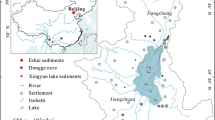Abstract
Estimates of the palaeo-subaerial wind direction were studied systematically for the first time by using the anisotropy of loess magnetic susceptibility (AMS) measurements in the northwestern China. One hundred and forty undisturbed oriented aeolian loess samples were collected from Lanzhou, Linxia and Wudu areas for AMS measurements, which indicated the subaerial wind directions were not the same while the loess deposited. From the Early Pleistocene to Middle Pleistocene till Late Pleistocene, the wind direction experienced an anticlockwise rotation in the studied area. We suggested this change was related to the uplift of the Qinghai-Xizang Plateau and the adjustment of current and landform effects.
Similar content being viewed by others
References
Ellwood B. B., 1978. Flow and emplacement direction determined for selected basaltic using magnetic susceptibility anisotropy measurements. Earth and Planetary Science Letters. (41): 254–264.
Ellwood B. B., 1980. Application of the anisotropy of magnetic susceptibility method as an indicator of bottomwater flow direction. Marine Geology, (34): 83–90.
Ellwood B. B., 1982. Estimates of flow direction for Call-alkaline welded tuffsand palaeo-magnetic data reliability from anisotropy of magnetic susceptibility measurements: central Sam Juan mountains, southwest Colorado. Earth and Planetary Science Letters, (59): 303–314.
Fang Xiaomin, 1994. Study on the source and cause of Malan loess on east margin and adjacent of Qinghai-Xizang Plateau. Science in China (Series B), 24(5): 539–546. (in Chinese)
Graham J. W., 1954. Magnetic susceptibility anisotropy, an unexploited petrofabric element. Bull Geol. Soc. Am. (65): 1257–1258.
He Shaoying, Sun Shiwei, Yang Piyuan, 1986. Anisotropy of Rock Magnetic Susceptibility. Beijing: Geology Press, 38. (in Chinese)
Liu Xiuming, Xu Tong Chun, Liu Dongsheng, 1989. The AMS and origin of Chinese loess and their significance in Quaternary research. Science in China (Series B), (4): 441–448. (in Chinese)
William D MacDonald, Ellwood B. B., 1987. Anisotropy of magnetic susceptibility: sedimentological, igneous, and structural-tectonic applications. Reviews of Geophysics, 25 (5): 905–909.
Ye Duzheng, Gao Youxi, 1988. Meteorology of Qinghai-Xizang Plateau. Beijing: Science Press, 44–60. (in Chinese)
Zhang Yutian, Chen Fahu, Cao Jixiu, 1993. Discussion on the property of loess magnetic susceptibility anisotropy. Journal of Lanzhou University (Natural Science), 29(2):153–160. (in Chinese)
Zhu Junjie, Cao Jixiu, Zhong Wei, 1994. Discovery of the highest terrace of Huanghe River in Lanzhou area and the study on the loess Palaeomagnetic Chronology. Study on the Evolution, Environmental Change and Ecosystem of Qinghai-Xizang Plateau. Beijing: Science Press, 77–90. (in Chinese)
Author information
Authors and Affiliations
Rights and permissions
About this article
Cite this article
Wang, J. The anisotropy of loess magnetic susceptibility in the northeastern fringe of Qinghai-Xizang Plateau as an indicator of palaeowind direction. Chin. Geograph.Sc. 8, 85–90 (1998). https://doi.org/10.1007/s11769-997-0086-x
Received:
Issue Date:
DOI: https://doi.org/10.1007/s11769-997-0086-x




